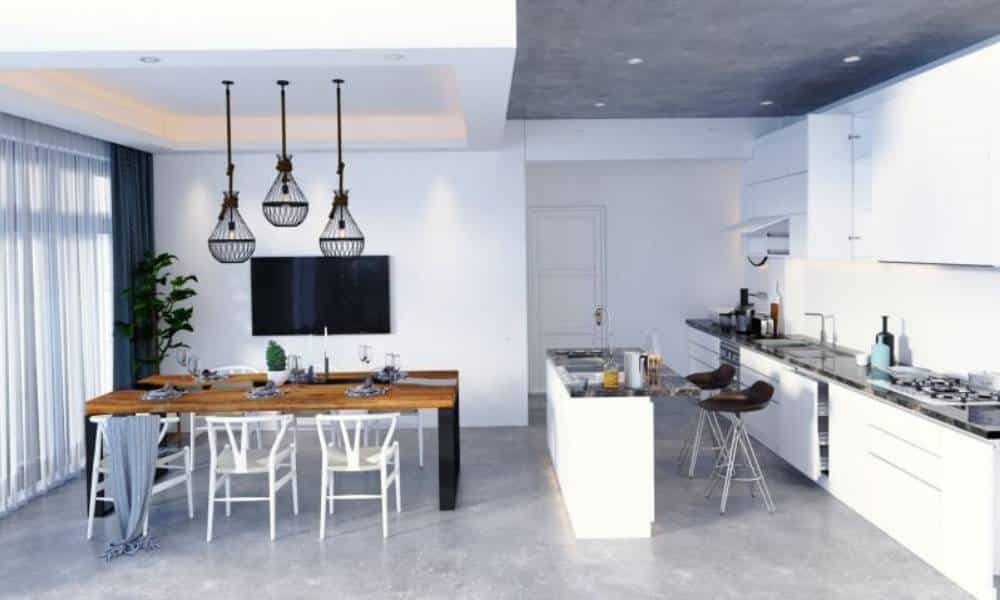Are you tired Of the mismatched lighting in your kitchen And dining area? If so, It’s time To learn how To pair kitchen And dining lights for A cohesive And stylish look. The right lighting can transform any space, Enhancing Its functionality And aesthetic appeal. In this article, We will explore different ways To create A harmonious lighting design that seamlessly connects your kitchen And dining area. Say goodbye To dull and disjointed lighting – Get ready To elevate the ambiance Of your home with these expert tips on how To pair kitchen And dining lights.
01. Consider The Style Of The Rooms
Before embarking on the quest of finding lights that harmoniously pair kitchen and dining spaces, one should first assess the individual styles present within these two essential spaces. Kitchens, often considered the heart of any home, tend towards functional designs with lighting designed for culinary tasks in mind.
Pendant lights with clean lines or recessed lighting can enhance a modern kitchen, while vintage-inspired fixtures may create the ideal atmosphere in more rustic kitchens. In the dining room – which often serves as the place where meals and conversations take place. Chandeliers or pendant lights suspended above the dining table add an elegant touch and set the scene for memorable dining experiences.
02. Layer Your Lighting
This approach involves the integration Of different lighting types To achieve An effective result. When lighting Is essential in performing daily tasks such As cooking, using recessed Or under cabinet fixtures provides sufficient illumination. Pendant lights suspended over key zones like An Island add functionality while simultaneously adding aesthetic value.
As soon As it comes time for dining, A chandelier Or pendant light should become the main focus. Pairing this primary source with wall sconces Or table lamps adds another layer that allows you To adjust its ambiance according To different occasions.
03. Choosing The Right Fixtures
Pendant lights or recessed lighting fixtures in a kitchen that emphasize practicality can be chosen according to what tasks need to be completed in each zone. For instance over sink or island areas for focused illumination. Choosing a chandelier, pendant, or both fixtures as part of a dining area chandelier varies based on space size and desired ambiance. Fixtures themselves often become design features, adding aesthetic value or contributing to the desired ambiance in terms of sleek modernism or classic ornateness of the room design aesthetics.
04. Coordinate Styles And Finishes
.Design in these spaces depends upon carefully selecting fixtures that share a common aesthetic language. Whether that means going for an aesthetically consistent or complementary aesthetic. Aligning design elements ensures an easy flow from kitchen to dining areas while considering finishes of fixtures are key in creating a polished appearance. For instance, matching pendant lights to cabinet hardware colors. And selecting chandeliers to pair well with dining room furniture all add layers of sophistication that create harmony within these rooms.
05. Consider The Size And Proportions
Functionality should always come first when selecting lighting fixtures. Size needs to correspond with the dimensions of the area being illuminated for best results. Oversized or undersized lights may disrupt visual harmony and reduce its efficacy. Similar to when lighting dining rooms where the scale of chosen fixtures plays an integral part.
An impressive dining table may require an elaborate chandelier as its center point. Smaller spaces may benefit more from subdued pendant lights or clusters of bulbs. Finding an optimal balance in size. Proportion ensures that lighting not only serves its practical purposes but also adds an aesthetic charm that enhances both kitchen and dining areas.
06. Play With Light Temperatures
Unleashing the true potential of kitchen and dining lighting requires thoughtful consideration of light temperatures. Varying warm or cool lighting impacts not only visual ambiance but also emotional ones. When designing functional living spaces such as kitchens both functionality and comfort must coexist. Using warmer tones may create an inviting ambiance, especially where family or friends gather.
Task lighting such as under-cabinet fixtures or pendant lights hanging above a dining table benefits from having cooler temperature lights that increase visibility and focus. The interaction of various light temperatures creates an adaptable and dynamic environment that caters to various activities and occasions.
07. Dimmers For Versatility
Dimmers provide practical control of illumination levels while simultaneously contributing to the atmosphere of dynamic spaces like kitchens. As tasks require precise execution and atmospheres are varied, dimmable under-cabinet lighting provides bright yet focused illumination during meal preparation. While overhead fixtures can be turned down for a more relaxing evening vibe. Chandeliers or pendant lights over dining tables give diners the ability to set any mood from intimate dinners to lively events with ease.
08. Try To Add Multiple Fixtures
This approach not only diversifies lighting sources But also adds visual interest To an otherwise monotone design. A mix Of recessed, pendant, And under-cabinet fixtures create A well-lit kitchen, Catering To varying tasks while emphasizing specific zones. Meanwhile, In dining areas multiple fixtures such as central chandeliers with wall sconces or buffet lamps create balanced illumination. Creating An inviting ambiance And warm, And welcoming ambiance. Achieve harmony among fixtures To prevent overcrowding while providing enough illumination coverage. These concepts should all come together when combined together.
Conclusion
Pairing kitchen and dining lights requires an exquisite balancing act between form and function. By considering styles, sizes, And finishes. Light temperatures, dimmers, and multiple fixtures – such as dimmers – can achieve a beautiful visual symphony that blends form and functions beautifully. By carefully orchestrating these living spaces beyond mere illumination into captivating realms that simultaneously balance practicality with aesthetic allure. Pairing kitchen and dining lights becomes a personalized expression that illuminates and welcomes every member of your household.





